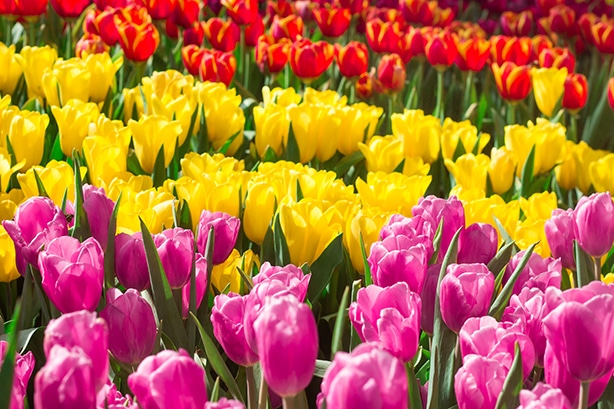For centuries, tulips have captivated us. From their wild beginnings in the mountains of central Asia, growers have been breeding and growing them to provide a dizzying array of sizes, shapes, colors and bloom times. And once you have planted bulbs, you’ll realize all that work in the fall yields big rewards.
How is a person to choose between all the different varieties?
Knowing how the different types perform will help give you the garden look you want. The variety you choose is as important as where you plant them.
A note on flowering times – it’s the climate, not the calendar. Early spring is a lot later in Minnesota than it is in Tennessee. And when it’s late spring in northern Wisconsin, it’s already summer in Texas. In Zone 5, “early” means mid-April and “late” means May.
All bulbs must be fall planted. Planted bulbs should be 6-8 inches deep unless otherwise noted. Use our handy guide to find the perfect variety (or varieties!) for your garden.
One common designing technique is to grow tulips along a well trimmed boxwood. Make sure to check out our article on how to trim your boxwoods!

Species Tulips
Also known as Wild Tulips, these little sweeties are the earliest to pop up and perennialize if given proper care. They come in a variety of bright, clear colors, often with a different colored center. Try ‘The Turkish Tulip’ (Tulipa acuminata), which has scarlet and yellow petals that are long and narrow. It dates back to the early 1800s. Cherry colored ‘Little Beauty’ with its blue center is a knockout. Plant these bulbs 4-5 inches deep.
Horticultural Zone: Varies, depending on the variety, but generally zones 3-8.
Flowering time: Early Spring
Size: Between 4 and 12 inches, depending on the variety
Colors: Red, yellow, orange, pink, lilac, white
Design Ideas: Good for naturalizing, in rock gardens, and planted in clusters and drifts with other early blooming bulbs such as mini daffodils, muscari, or scilla.
Fosteriana

Another early bloomer, Fosteriana – also known as Emperor – growing up to 2 feet tall depending on the variety. They can return for a few seasons with proper care, so interplant them with perennials like sedums and daylilies that don’t require a lot of water and where the bulbs can stay undisturbed.
Horticultural Zone: 3 to 8
Flowering time: Early Spring
Size: 14 to 20 inches high
Colors: Red, apricot, orange, yellow, white, pink
Design Ideas: Interplant with other, later flowering tulips for a long-lasting display. Plant in clusters near early-blooming shrubs and trees using complementary or contrasting colors.
Water Lily

Kaufmanniana look like water lilies with their open faces and pointy petals. They can naturalize if given proper care, returning for many years. They open wide in full sun revealing a hidden, inner hue. Place them where they can be viewed from above!
Horticultural Zone: 4 to 8
Flowering time: Early Spring
Size: 8 to 10 inches tall
Colors: Red, white, yellow, pink, orange, bi-color
Design Ideas: Use in rock gardens and perennial borders. Enjoy a cluster by your front door. Pair with other early blooming plants like candytuft and brunnera. ‘Sweetheart’ or ‘White Emperor’ are gorgeous with dark-leaf heucheras. Scatter into groundcover beds of vinca, pachysandra, or wild ginger.
Single Early
Perfect for an early-season garden show, they will be finished blooming when you’re ready to plant summer annuals. Strong stems and large flowers hold up well in unpredictable weather.
Horticultural Zone: 3 to 8
Flowering time: Early Spring
Size: 12 to 18 inches high
Colors: Red, white, yellow, purple, orange, purple, bicolors
Design Ideas: Use in borders, flower beds and containers. A wide range of colors lets you create fabulous color-blocked displays. Put two complementary or contrasting colors together, or do a mix. Use with spring-planted annuals, such as pansies, for a pretty garden look. Combine with Darwin Hybrid Tulips for months-long beauty.
Double Early
Double layers of petals give these tulips a fluffy open-rose look. Despite their delicate style, these are strong and will hold up to springtime rains. They bloom early, so you can remove them when you want to plant your annuals without sacrificing a single blossom.
Horticultural Zone: 3 to 7:
Flowering time: Early Spring
Size: 12 to 16 inches high
Colors: Pinks, purple, white, yellow, bicolors
Design Ideas: Try ‘Monsella’ – a bicolor with fluffy orange and yellow petals – against a dark evergreen hedge. Try a large “ribbon” of mixed colors in your groundcover bed. Mix double early and double late together for a long-lasting show. Scatter under early blooming trees. Or buddy them up with spring-planted annuals, like pericallis.
Greigii
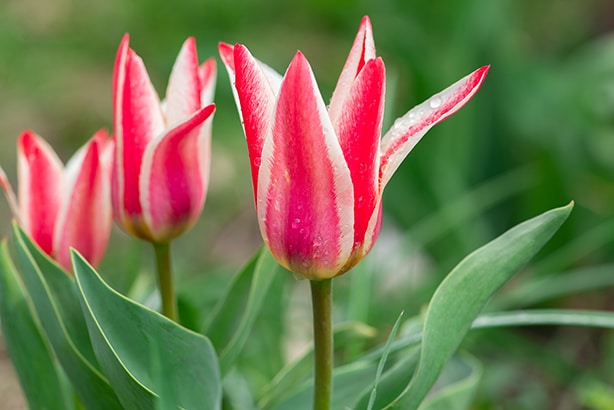
Sweet and small, the Greigii variety doesn’t have the color range that other types do, but the colors are vibrant. Furthermore, the mottled foliage creates a delightful appeal. Place them where their beauty can be observed up close.
Horticultural Zone: 3 to 7
Flowering time: Mid-Spring
Size: 8 to 14 inches tall
Colors: Red, orange, white, yellow, pinks
Design Ideas: Use in rock gardens, beds, and containers. Try award-winning ‘Little Red Riding Hood’ with muscari. ‘Mary Ann’ would pair perfectly with heucheras and dicentra.
Also check out our article on common problems and diseases that your flowers may face so that you can troubleshoot the issue before it becomes too late.
Lily Flowered
Sometimes referred to as Lily Flowering, these charmers shave a fairy-like quality. Elegant flute shaped flowers in vibrant colors stand atop long, strong stems. Some are fragrant, adding to their appeal.
Horticultural Zone: 3 to 7
Flowering time: Mid-Spring
Size:18 to 24 inches high
Colors: Red, white, pinks, yellow, purple, orange, bi-colors
Design Ideas: Beautiful cut flowers – try them in a bouquet with lilacs. Use Lily Flowered with more formal looking garden plants, like clipped boxwood hedges or let them casually mix with creeping phlox or evergreen groundcovers.
Multi-flowering
These Bouquet Tulips are just that – a bouquet on one stem! The flowers are full size, with 4 or more per stem. So you get a lot of “bang for your buck” here: plant one bulb, get four flowers! Some of them change colors as they mature. For instance, ‘Antoinette’ begins as pale yellow, then turns orange.
Horticultural Zone: 3 to 8
Flowering time: Mid Spring
Size: Between 14 and 20 inches tall
Colors: Pinks, purples, yellow, red
Design Ideas: Lovely in flower arrangements, garden borders, or one big bed all to themselves. Edge a walkway or fill up a big urn – this gorgeous variety will get a lot of “likes”!
Fringed
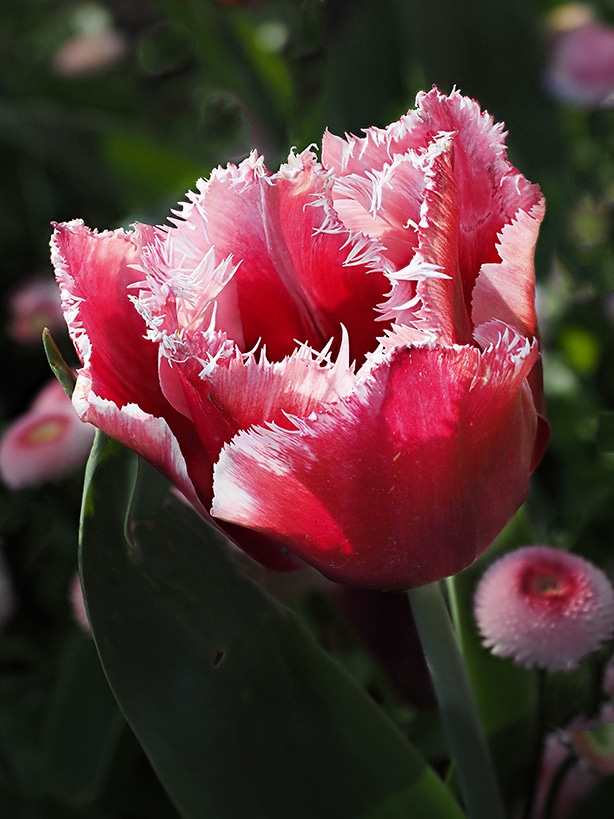
Also known as Crispa, these are dramatic and showy with fringed edges that create a frosted look. Place these breathtaking bulbs where they will be noticed; many are award winners. A must-have for your garden.
Horticultural Zone: 3 to 8
Flowering time: Mid-Spring
Size: 16 to 20 inches high
Colors: Pink, white, orange, purple, bi-colors
Design Ideas: Great in stand-alone beds, borders or containers. Lovely in a bouquet. Try “Cummins’ and ‘Honeymoon’ with spring-planted Regal geraniums.
Parrot
As flamboyant as the birds they’re named after! Curvy, fringed petals look like ruffled feathers. Despite their exotic look, these are tough and can handle springtime storms. The large flowers steal the show in any garden you create.
Horticultural Zone: 4 to 7
Flowering time: Mid-to-late spring
Size: 14 to 22 inches high
Colors: Often bi-colored, pinks, purple, yellow, red, white
Design Ideas: Wonderful in bouquets. A single Parrot Tulip can bloom in a glass forcing jar for a dramatic effect. Outstanding in a bed of their own – use one variety, or mix a few together for a striking display. This variety doesn’t always play well with others, so let them show off in their own particular space.
Viridiflora
Sometimes called Green Tulips, these fragrant beauties all have one thing in common – some of the petals are streaked and flashed with green! Far from boring, these unusual markings give a delicate look that is sure to invite a second look.
Horticultural Zone:3 to 7
Flowering time: Mid-to-late Spring
Size: 12- to 22 inches tall
Colors: red, white, orange, purple, pink – always mixed with green, of course!
Design Ideas: Mixed in with single early tulips, Viridifloras can extend your flower season. Try the variety ‘Spring Green’ interplanted with your variegated hostas and forget-me-nots for a calm and restful look. Makes an excellent cut flower. Consider using these in a bouquet and enjoy their fragrance close up.
Darwin Hybrid – Single Late
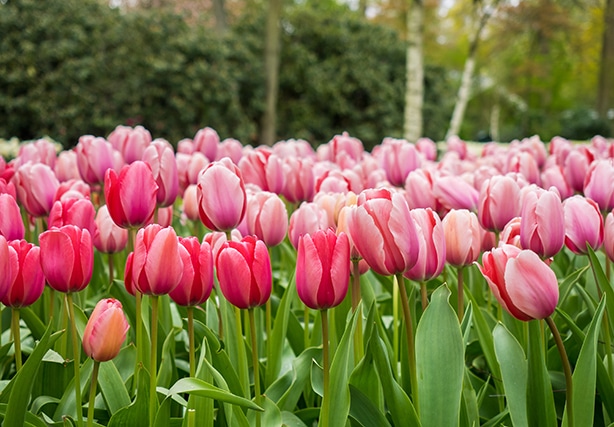
These are one of the most popular varieties. This type is the one that everybody knows and loves. Sometimes called Cottage Tulips, they grow on strong stems. Darwins can return with proper care, making them perfect for adding to your perennial beds.
Horticultural Zone: 3 to 8
Flowering time: Late Spring
Size: 20 to 30 inches high
Colors: Red, yellow, orange, white, pinks, purple, cream, apricot, rose, nearly black, bi-colors…all in various shades and combinations
Design Ideas: Use with reckless abandon! Edge a path, circle a lamppost, or embrace a flowering crabapple. Ribbons, drifts, clusters, and entire beds – all with one variety or in combinations. Planting with Single Early tulips gives a continuous show. ‘Queen of the Night’ is a purple so dark it looks black. Pair it with yellow Japanese Kerria for a modern twist.
Double Late
A double ring of petals set these apart from the pack. And give them their alternate name, Peony Flowering Tulips. They also look like roses or poppies. The large flowers offer long-lasting beauty in a bouquet.
Horticultural Zone: 3 to 7
Flowering time: Late Spring
Size: 16 to 22 inches tall
Colors: Pinks, white, yellow, red, orange
Design Ideas: “Angelique’ looks delightful with purple bearded iris and white Darwin Hybrid Tulips. ‘LaBelle Epoque’ is a moody, rosey bi-color that would look fantastic with blue leaf hostas under a serviceberry. Beautiful in bouquets.
Rembrandt
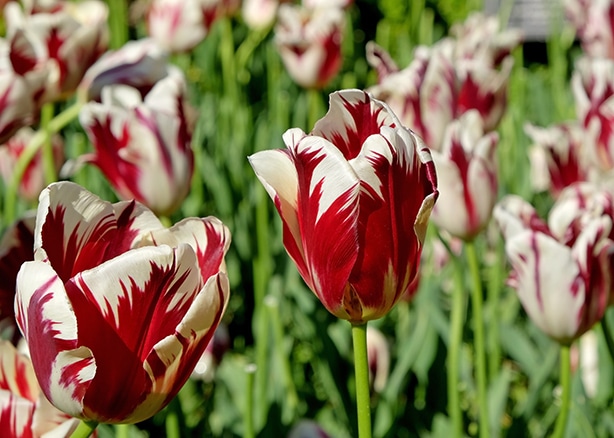
These tulips are not a separate classification but worthy of their own category. A Rembrandt is a Single Late Tulip with multi-colored petals. The coloration mimics 17th-century plants that were infected with a virus. Not realizing these “broken” tulips were diseased, growers and brokers drove up the market for these rare, doomed beauties….until it crashed. Today’s Rembrandts are disease-free, and this variety is still highly prized.
Horticultural Zone: 3-8
Flowering time: Late Spring
Size: 20 inches high
Colors: Colored “breaks” swirls and streaks of color – red/yellow and red/white
Design Ideas: Buy a mix and plant close together (4 inches instead of 6 inches apart) in one great big pot or two pots on either side of your front door. Combine red/white Rembrandts with deep purple irises or blue perennial salvia.

